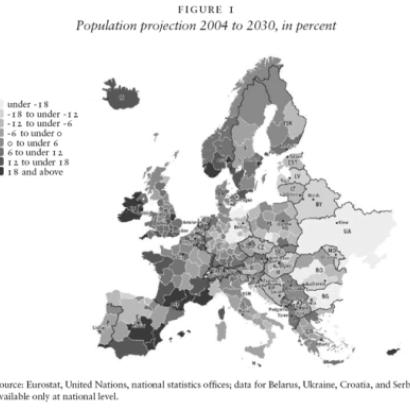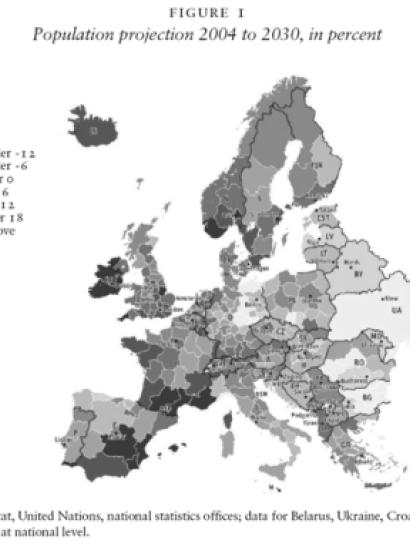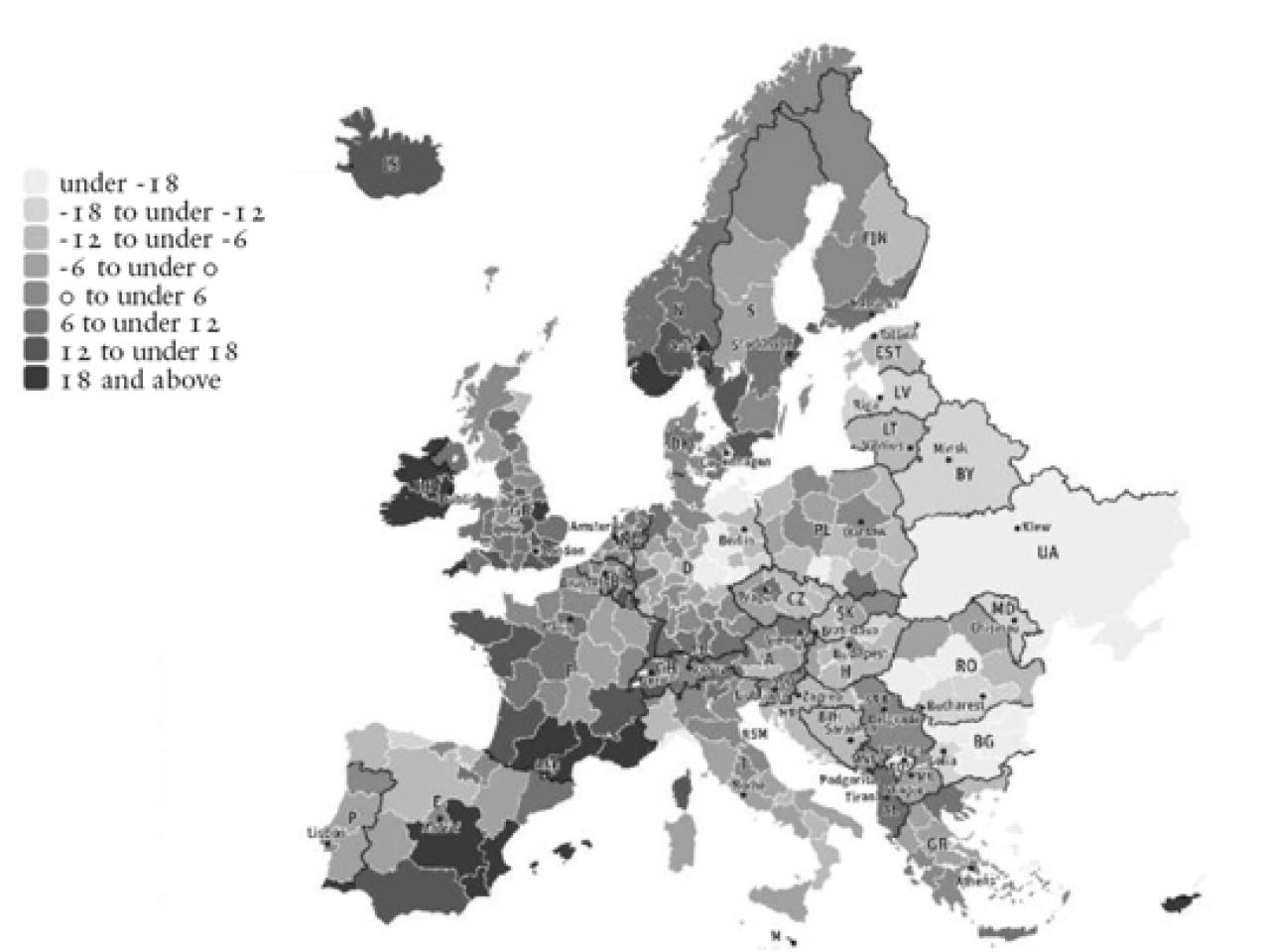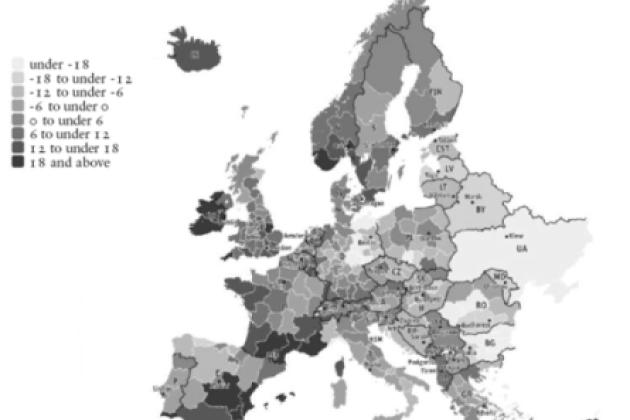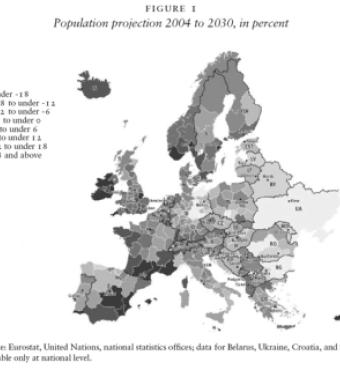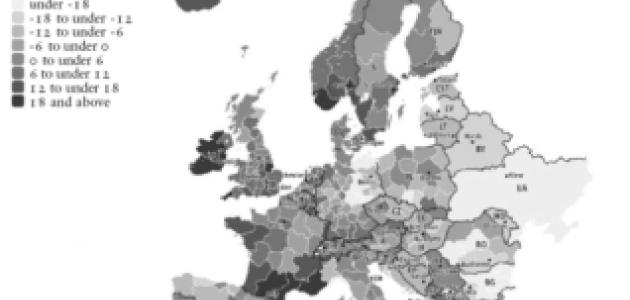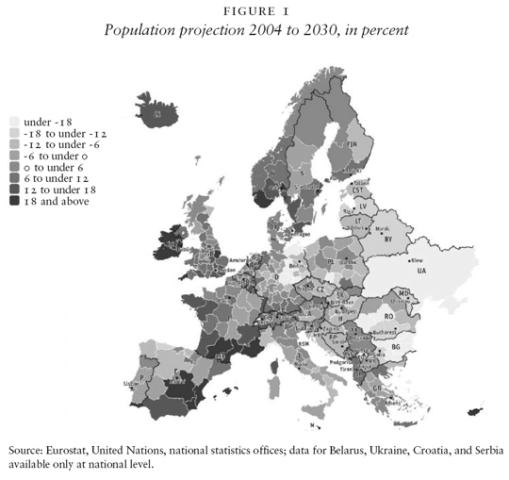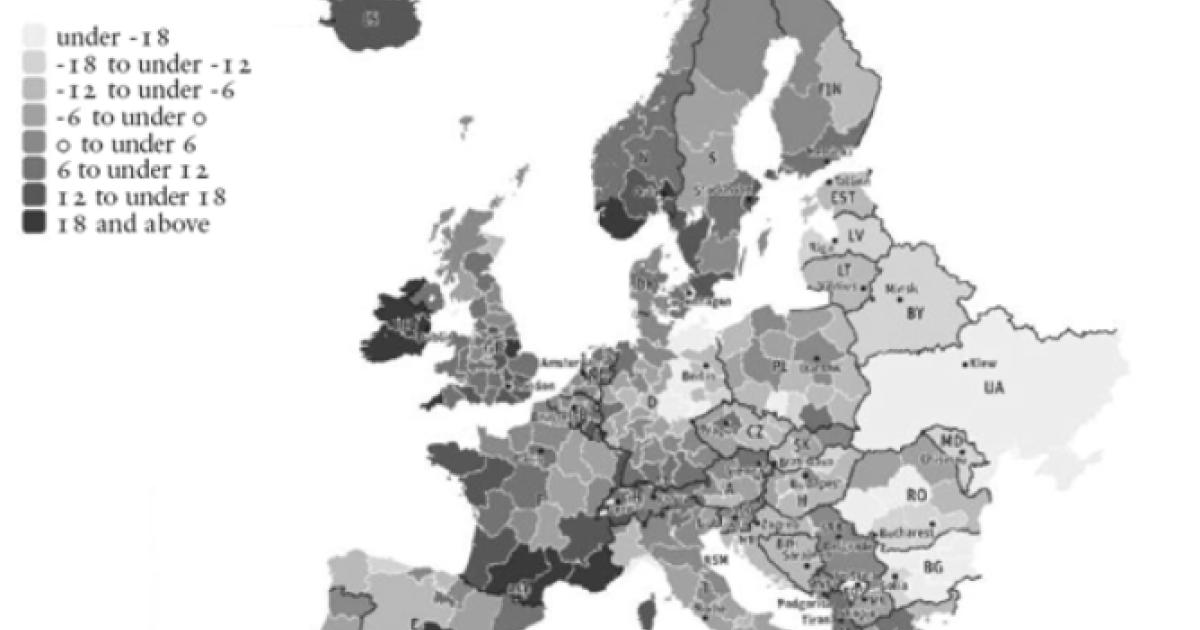- International Affairs
- Politics, Institutions, and Public Opinion
Paging through american books or media reports on demographic change in Europe, one could conclude that the old continent is on its way to doom: Graying and shrinking, the Europeans sacrifice their occidental culture in favor of hordes of migrants from the south and the east. Walter Laqueur’s book, The Last Days of Europe, pictures Europe as too decadent to reproduce — a place where only the uncultured masses, notably Muslim immigrants, have a considerable number of children. In other words, Europe is at demographic war with the rest of the world, and it can only lose.
Of course, there is some truth in the basis figures (not necessarily in the conclusions) of these scenarios: Travel between Lisbon and Chişinău, the capital of tiny and poor Moldova, and you’ll travel through countries where birthrates are low. In the European Union, women have 1.5 children on average, a number much too small to sustain a stable population. In 1957, when the European Union was founded, each of today’s 27 eu members had fertility rates above 2.1 children per woman. What’s more, the baby boomers are going to be replaced by a generation that is barely two thirds as large. How can these shrinking post-baby boomers generate the wealth needed to care for their aging parents and at the same time invest so much into innovative industries such that they can compete with the young and fertile populations on other continents?
As all European nations age, some, such as Germany and Romania, have already started to shrink. Others will soon follow. Wherever fertility rates are appreciably below 2.1 there is no way, in the medium term, to reverse the trend toward natural population contraction. In 2008, eight out of 27 eu countries reported more deaths that births. Before mid-century, when the baby boomers will die out, a great number of nations will see dwindling population numbers. According to common population forecasts, the eu will lose some 50 million of its current inhabitants by the year 2050 through an excess of deaths over births — that is ten percent of today’s inhabitants or roughly the populations of Poland and Greece combined. Most European countries will be able to achieve population growth, or even simply stability, only on the basis of immigration.
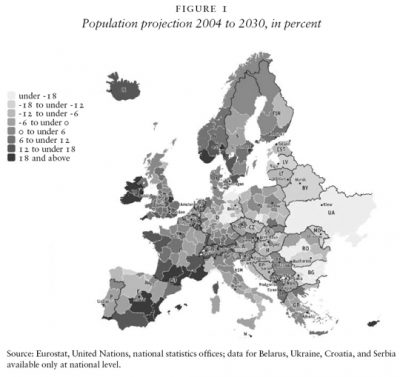
In fact, the natural losses will most certainly be compensated for by an equal number of immigrants over the next four decades, a figure that cannot be too disturbing for America or Canada, where almost everybody has a migration background. So despite low birthrates, eu-27’s population will remain more or less constant until mid-century. From today’s 500 million, it is estimated to peak at 520 million around 2035 and decline afterwards. As non-eu countries like Ukraine or Belarus are not likely to gain enough immigrants to compensate for the low fertility, Europe in total will definitely shrink. Europe’s demographic share will also decline as all other continents continue to grow: the Americas will, and Asia will grow by about 30 percent. Africa’s population will double by 2050. As a result, some scholars expect “massive shifts in economic and military potential” and “significant security challenges to Europe over the next two decades.”
Europe: Demographic trendsetter
All this makes Europe the pioneer of a demographic trend that, sooner or later, will reach most corners of the world. World population nearly quadrupled during the past century. And it still grows by about 230,000 heads per day. With a population of 6.8 billion and resource consumption and pollutant emissions far beyond the limits of sustainability, humankind has reached a size at which it poses a danger to itself. This problem will increase as world population moves up to 9.4 billion in 2050.
It was always clear that at some time, in some region of the world, the trend of demographic increase would reverse. Europe is the pioneer. And in this pioneering continent Germany is the frontrunner, because low fertility rates (two children replacing every three adults) have been common there for 35 years. Since 1972, Germany has not seen a single year where the number of newborns exceeded the number of deaths. The creeping population-shrinking process was only masked by high immigration figures that could camouflage the natural losses — at least until 2003. Since then, the overall population of Germany has declined; the Federal Statistical Office expects that the nation will have around eight million fewer inhabitants by mid-century — a loss that is the equivalent of losing the populations of Berlin, Hamburg, Munich, Cologne, and Frankfurt combined. Germany, along with Ukraine and Romania, presently lead the league of European countries with populations set to contract.
By 2030, most middle and east European regions, including eastern Germany, will face serious population losses. These will be most severe in remote rural areas that have weak economies. Stability or even growth can be expected only in and around the capital regions of middle and east Europe, where most of the foreign investment has happened and most of the new jobs were created after the end of communism. Low fertility countries will shrink in their agricultural regions: Spain will shrink in the north and Italy in the south. On the other side, high fertility countries like Norway, the uk, and France might be able to offset the losses of their less-developed areas because of an overall growing population.
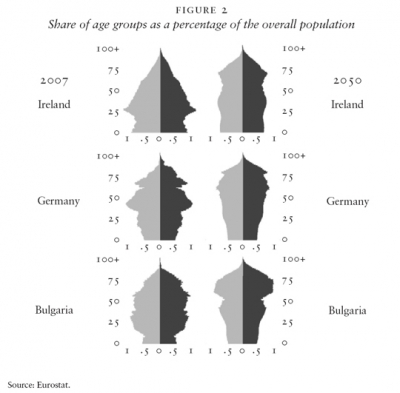
Social and economic challenges
As the baby boomers age and life expectancy continues to rise, the median age of the European population, which stood at 31 in 1950, had reached 38 in 2005 and is set to rise to 48 by 2050. Europe’s population is aging by roughly two days a week, and elderly people will soon outnumber young people. Around 2045, Europe will reach the peak of its aging process. After that the baby boom generation will leave the population pyramid and Europe will turn a new page in its demographic chronology. Until then, it will be necessary to adapt pension and health care systems to a large increment of elderly people.
Most European countries will see a decline in their workforces over the next several decades — mainly very low fertility nations such as Germany, Italy, or Poland. High fertility nations such as France or Ireland, by contrast, can expect the numbers of their working-age populations to remain unchanged. In all of Europe the number of people over age 60 is set to rise by more than 50 percent between 2004 and 2030. The size of the working-age population (those between 15 and 64) in the eu stood at 334 million in 2008; it will shrink to 328 million in 2025 and to 294 million in 2050. At today’s labor force participation rates, the number of people in the actual workforce will drop from 238 million, where it stood in 2008, to 207 million in 2050 — without immigration the number would drop to 169 million. At the same time, these countries are challenged to keep productivity high in order to remain competitive on a global level. Probably the fast-growing economies in Asia and Latin America will begin to surpass Europe in economic productivity.
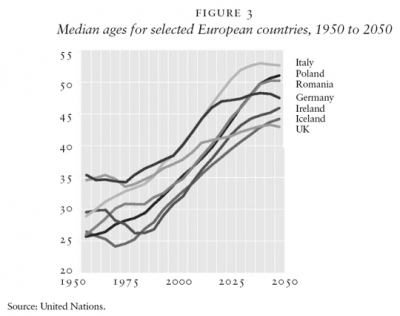
The former communist countries in Central and East Europe are under even greater pressure. They show the signs of an array of negative demographic phenomena: very low fertility rates; massive outward migration of young people; and, as a consequence, pronounced aging of the remaining population. As they often do, demographic and economic trends go hand in hand: Larger-sized companies, which once employed tens of thousands, have vanished, and agriculture provides fewer and fewer jobs. People without jobs have either moved away for a better future or are barely able to save for their pension age. Unfortunately, the social security systems in these countries are not yet evolved enough to provide adequate resources to their retirees.
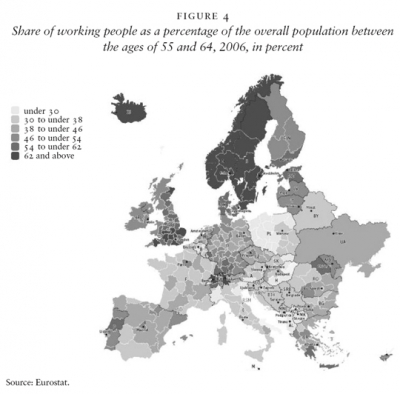
Nevertheless, Europe is not alone in undergoing such challenges: Japan and South Korea are aging even faster. Emerging nations such as China, Malaysia, and Indonesia will see the same demographic changes in a compressed way, and they probably will grow old before they can become rich. Whereas in France it took 115 years to double the percentage of population (from seven percent to 14 percent) of people over 60, Thailand will need only about 20 years to undergo the same process. And even the U.S., with a birthrate around replacement level and persistent immigration, is facing an aging baby boomer generation (one that is also less healthy than that in Europe) and, thus, has an urgent need to reform its health care and pension systems.
Working longer is one option to counter a shrinking workforce. But extending the retirement age can only partly solve the problem of an aging population, because it is the very old who are aging the fastest. Today, 20 percent of Germany’s population is older than 65, and 5 percent are older than 80. In 2050, the 65-plus age group will make up 32 percent and the 80-plus group 14 percent. In other words: By mid-century one out of seven Germans will be older than 80. The figures are similar in Spain and Italy. The Old World will then truly be the oldest.
No solutions — only adaptation
There is no quick fix, no magic solution for all these problems. The groundwork for the demographic changes was laid decades ago. There is no way to close demographic gaps once they have opened. There is only one way out: Europe’s populations and governments need to learn to deal efficiently with the coming changes in order to prevent them from growing in scope.
Therefore, the demographic future is an inescapable inducement to better integrate migrants, to make them more productive, to improve the efficiency of education and health systems, to adopt more modern family policies, to overhaul public budgets, and to make social security systems demography-proof.
The good news is that Europe, with its huge number of cultures, concepts, and ideas, already has a great many models for dealing with these challenges. Some nations are better prepared than others, and if all nations can learn to learn from each other, the old continent would not only be the pacesetter in the process of demographic change but also the pioneer in dealing with these problems.
The pressure for reforms and renewal is not new. But in the face of the demographic development the Europeans will learn to analyze and plan more effectively under economic considerations: Because Europe will have fewer young brains responsible for a higher productivity in the future, it can compensate for the demographic losses only through education. Viewed in economic terms, poorly educated young people tend to end up as costly welfare cases, unemployed migrants are a burden to the welfare state, and low birthrates undercut the labor market. The old continent’s most important resource — its minds and talents — will be valued more highly in the future. Qualified young people will no longer have to stand in line to get a job — indeed companies will compete for them.
The individual European countries differ considerably in terms of the progress they have made on the path from the industrial to the knowledge society. Some countries invest more efficiently in education, science, and technology than others and, accordingly, have many highly qualified workers, a fact that translates directly into high productivity and income. The prospering economies of Switzerland and the Scandinavian nations clearly show the right road for post-industrial societies. Sweden, Denmark, and Norway are leaders when it comes to science and technology. More than 40 percent of Sweden’s workforce is active in these fields; over half of these workers are university-trained. Ever since the start of the oecd-pisa study, which compares international education, the world has known that the Finns do just about everything right with their schools. This is the backbone for its successful “Nokia” economy. This is remarkable because Finland, the sparsely populated “land of lakes and forests,” is disadvantaged by its remote position at the northern edge of Europe and its complicated language, which is not widely spoken. But there is no reason to believe that other countries in Europe cannot learn from the Finnish experience.
While education is the central answer to Europe’s demographic problems, it is also a necessary precondition for another policy option: Working longer. In more than half of the eu nations the retirement age is currently below 60, and for women it is even lower. As a consequence, the employment rate in the age group 55–64 is as low as 40 percent. In many eu countries life expectancy (today it is 77 years for men, 82 years for women) continues to rise by three years per decade; for some Europeans, the length of their retirement will soon exceed that of their working life.
Of course, this trend is not sustainable and the luxury of early retirement would ruin all pension systems. The old arguments for early retirement programs seem to rest on a mistaken premise, namely that such programs would prevent unemployment among young people during the time when the baby boomers were pushing into the job market. But if one examines the basic statistics it becomes clear that the lowest overall unemployment rates are in countries where employment rates for the age group 55–64 are highest. In these countries, mainly Norway, Sweden, and Switzerland, people 55 and older are so productive that they create more jobs than they block. Productive and innovative economies apparently do not run out of work.
But if companies start, for demographic reasons, to employ more elderly persons, they will necessarily have to invest more in skills-enhancement. This is exactly what these countries already do today and what other countries still have to learn. Participation rates in skills-enhancement programs — 4 percent in Portugal and 6 percent in Italy, as opposed to 32 percent in Sweden — show that the economic usefulness of elderly people is widely underestimated in many countries. The demand for lifelong learning is growing fast.
Gender equality in family, work, and pay is another issue. The economy needs women no less than it needs children. And it will, for purely economic reasons, have to ensure that family and job are compatible, on equal terms, for both partners. Again, there are good examples in Europe of how to achieve much higher female labor-participation. Women work in greater numbers in countries in which many people over age 55 work. Qualified women in the labor force make these economies even more productive and competitive. Interestingly, these countries show disproportionally high fertility rates, thus proving that a modern family policy makes a lot of sense not only for economic reasons.
But what is a modern family policy for Europe? To answer this question it is worth taking a look at Europe’s fertility map.
Europe’s fertility belt stretches from Finland over the uk and Ireland to France. The rest of Europe — Spain and Italy, Germany and Austria, Central and east Europe — is low-fertility terrain, reporting around or below 1.4 children per woman. The only exception in the east is the new nation of Kosovo, a small and poor relic of the former Yugoslavia, which is not a member of the eu. There is nearly no middle ground of fertility in Europe (there are only haves and have-nots) and, even more interestingly, the fertility gaps between the different nations can be traced clearly along the national borders, making it highly plausible that the different fertility rates can be explained by different national family policies.
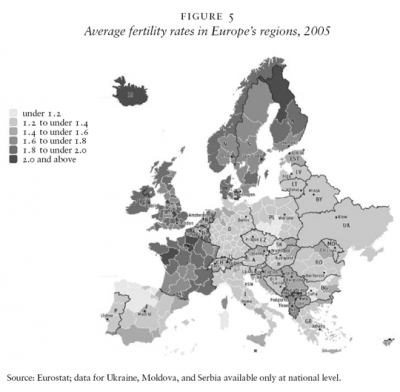
Declining birthrates worldwide are associated above all with a changed role for women in society. Since the 1960s, European women have gained equal access to education and they have made good use of it. In most European countries young women are better qualified than their male counterparts. It is unsurprising that these women want to use their education precisely the same way men have long done: to help them get a job and earn an independent income.
Some demographers are convinced that prosperity and increasing personal freedom leads a society to a “demographic-economic paradox”: The further a society is developed in economic terms, the fewer children its women will have. Population decline, in that theory, is the price to be paid for modernization and prosperity. But today there is no statistical proof that the demographic-economic paradox is true. It was only until the 1980s that a negative correlation between fertility rate and female employment could be observed: Until then, countries with high female labor-force participation had the lowest birthrates in Western Europe, and vice versa. Today the reverse is true: In Western Europe as in all the world’s industrial nations there is a positive correlation between female labor-force participation and fertility rates. In high-fertility countries like Sweden, Norway, Iceland, and Denmark, far more women are employed than in low-fertility countries like Italy, Greece, Spain, and even Germany.
Polls tell us that young people in Europe continue to want children, but that they have children in larger numbers only in countries that enable both parents to reconcile the demands of family and job. To put it simply: Where parents have the chance to easily combine family life with a job, where high-quality childcare facilities and full-day schools are the standard, the fertility rate is high. Also, it is the Calvinist countries that record the high birthrates. Most probably this is because the Calvinist work ethic expects all members of a society, women and men, to contribute to it through work. These countries invested earlier than others in equal education for men and women. And they realized the need for a consistent and modern family policy to prevent the fertility rate from dropping.
Yet, some countries might not profit too much too soon from a better family policy. In Germany and Austria, for example, low fertility has become a social norm, and the number of children that people want has dropped. These countries might be caught in a low-fertility trap and can only hope to stabilize their countries by immigration.
Sustainable development
There is no reason to propagate only a pronatalist policy to raise the fertility rate in Europe. In the face of an overpopulated world, immigration of talented migrants should be able to fill the continent’s labor market gaps when necessary. The history of all classical immigration countries shows that this is a viable option. Switzerland, a country with one of Europe’s highest share of immigrants, shows perfectly how profitable immigration can be.
Discussion about European demography should focus less on human quantity and more on human capacity. Population growth in itself is more a problem than a chance. Countries that learn to live in prosperity with an aging, a stagnant, or even a shrinking population will be the trendsetters for a sustainable future. Europe has no other chance than to learn to live with these changes. Europe will build the blueprint for modern societies of the future, for economies that build their wealth and well-being not on growth but on stability.







